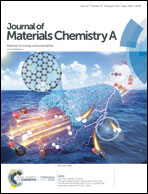Achieving high thermoelectric performance through constructing coherent interfaces and building interface potential barriers in n-type Bi2Te3/Bi2Te2.7Se0.3 nanocomposites†
Abstract
Although Bi2Te2.7Se0.3 is the best n-type thermoelectric material near room temperature, its energy-conversion efficiency η reported so far is still low. Hence, it is imperative to increase its η so as to realize widespread applications in heat recovery. Here, we show that through incorporation of Bi2Te3 (BT) nanoinclusions in Bi2Te2.7Se0.3 one can construct a large number of coherent phase boundaries and build effective interface potential barriers, based on which high electron mobility and energy-dependent carrier scattering are realized simultaneously. As a result, as large as 11% elevation of power factor is reached besides a large drop (53% at 300 K) of lattice thermal conductivity in the composite with 0.5 vol% BT nanoinclusions. Consequently, both a record high figure of merit ZTmax = 1.35 (at 414 K) and a record large ZTave = 1.28 are achieved in the operating temperature range of 300–525 K, which allow us to obtain an unprecedented conversion efficiency η = 10.5%. The present work demonstrates that incorporation of isostructural nanoinclusions in Bi2Te2.7Se0.3 is an effective approach to improve its thermoelectric performance.



 Please wait while we load your content...
Please wait while we load your content...